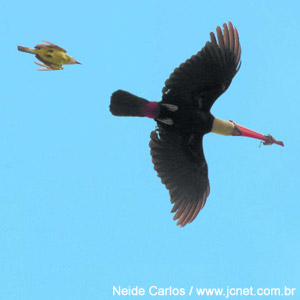Magazine | Analyses
Le Toucan toco n’est pas qu’un paisible oiseau frugivore

Tyran quiquivi (Pitangus sulphuratus) poursuivant « courageusement » un toucan toco (Ramphastos toco) qui vient d’emporter l’un de ses oisillons dans le nord-ouest du Brésil.
Photographie : Neide Carlos / Site web de la ville de Bauru
Introduction
Le Toucan toco (Ramphastos toco) est un oiseau spectaculaire, connu pour son énorme bec coloré, vivant dans les milieux semi-ouverts d’Amérique du Sud. Il est principalement frugivore, mais il apprécie aussi les insectes, les œufs et les oisillons. Le 2 novembre 2012, le site web de la ville brésilienne de Bauru, a publié une impressionnante photo de Neide Carlos prise dans le nord-ouest du Brésil, sur laquelle l’on voit un Tyran quiquivi (Pitangus sulphuratus) poursuivant courageusement un toucan qui vient d’emporter un oisillon.
Bruno Tredez avait « immortalisé » en octobre 2007 un couple de Toucans toco pillant consciencieusement les nids d’une colonie de Cassiques cul-rouge (Cacicus haemorrhous) près des chutes d’Iguaçu au Brésil.
Abstract
The Toco Toucan (Ramphastos toco) is the largest and arguably best known species in the toucan family. It is found in semi-open habitats throughout a large part of central and eastern South America. It has a striking plumage, but its most noticeable feature, however, is its huge bill, which is yellow-orange, tending to deeper reddish-orange on its lower sections and culmen, and with a black base and large spot on the tip.
This Toucan eats mainly fruits, but also insects, nestlings and eggs of birds.
The city of Bauru website, published an impressive photo of Neide Carlos showing a Great Kiskadee (Pitangus sulphuratus) chasing a Toucan who just took one of its nestlings from its nest.
During a birding trip in October 2007 in Brazil, Bruno Tredez, while he was having a drink in a garden of an hotel near the Iguaçu Falls, watched a pair of Toco Toucans robbing eggs in the nests of a colony of Red-rumped Caciques (Cacicus haemorrhous); he took photos of all the scene. You can discover other photos taken by Bruno during his trip in Brazil in his website: bruno.tredez.com.
Poursuivez la lecture de cet article, en vous abonnant dès maintenant !
Découvrez les Archives d’Ornithomedia.com
Pour seulement 10,00 €TTC/an (ou 6,00 € les 6 mois)
Profitez de plusieurs centaines d’articles en accès illimité et sans aucun engagement.
Compléments
À lire aussi sur Ornithomedia.com
Le bec du toucan est un bijou de mécanique
À lire sur le web
Ouvrages recommandés
- A Field Guide to the Birds of Brazil de Ber van Perlo
- A Photographic Guide to Birds of Southern Brazil de Clive Byers
- Brazil National Map (1er février 2011) de Michelin Editions des Voyages
Sources
- JCNET.com.br (2012). Bem-te-vi, Bem-te-quero. Date : 02/11. http://www.jcnet.com.br/Geral/2012/11/bemtevi-bemtequero.html
- J. V. Remsen, Jr., Mary Ann Hyde, Angela Chapman, The Diets of Neotropical Trogons, Motmots, Barbets and Toucans, The Condor, Vol. 95, No. 1 (Feb., 1993), pp. 178-192
- Charles Duca, Miguel Â. Marini (2005). Temporal variation in the reproductive success of Cacicus haemorrhous (Linnaeus) (Aves, Icterinae) in an Atlantic Forest reserve in Southeast Brazil, Rev. Bras. Zool. vol.22 no.2 Curitiba June 2005
- Ragusa-Netto J. (2006). Abundance and frugivory of the toco toucan (Ramphastos toco) in a gallery forest in Brazil’s Southern Pantanal, Braz. J. Biol. vol.66 no.1a São Carlos Feb. 2006
- Marco Aurélio Pizo, Camila I. Donatti, Neiva Maria R. Guedes, Mauro Galetti (2008). Conservation puzzle: Endangered hyacinth macaw depends on its nestpredator for reproduction. Biological Conservation. Volume 141, numéro 3, pages 792–796. http://www.sciencedirect.com/science/article/pii/S0006320708000104
- Paul Smith (2006). Interspecific aggession in netsing Great Kiskadees (Pitangus sulphuratus) in Paraguay. Boletín SAO. Vol. XVI (numéro 01). Juillet. http://www.avibirds.com/pdf/G/Grote%20Kiskadie3.pdf





 1 commentaire
1 commentaire
1 commentaire(s) sur ce sujet
Participer à la discussion !David Bismuth
sevran
Posté le 09 novembre 2012
Bonjour,
Sur notre page Facebook, Roberto Lamego nous précise que ces toucans ont « envahi » les forêts (par exemple celle de Valença) de l’État de Rio de Janeiro et constituent un problème pour l’avifaune locale… Voir ses commentaires sur https://www.facebook.com/ornithomedia